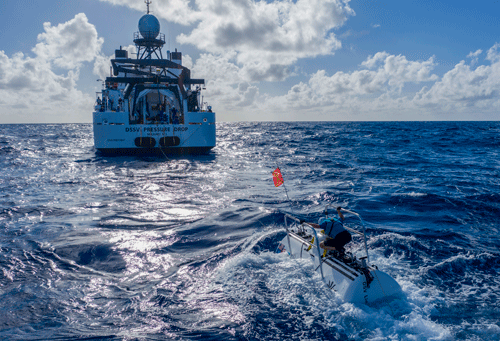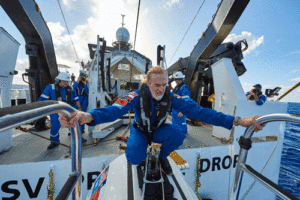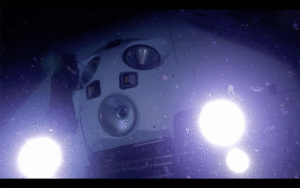
Dallas financier and explorer Victor Vescovo has just completed the world’s deepest-ever manned submarine dive – and he accomplished the historic feat aboard a Triton submersible designed and built in Indian River County.
 In late April, Vescovo plunged solo to a depth of 35,853 feet in the Mariana Trench in the Pacific off the island of Guam – 52 feet deeper than any previous manned exploration and, at four hours, the longest time any individual ever spent at the bottom of the ocean. The depth was measured using the powerful EM124 sonar aboard the expedition’s support ship, Pressure Drop.
In late April, Vescovo plunged solo to a depth of 35,853 feet in the Mariana Trench in the Pacific off the island of Guam – 52 feet deeper than any previous manned exploration and, at four hours, the longest time any individual ever spent at the bottom of the ocean. The depth was measured using the powerful EM124 sonar aboard the expedition’s support ship, Pressure Drop.
The Mariana probe is the fourth in Vescovo’s year-long Five Deeps campaign to pilot his sub, Limiting Factor, to the bottom of the five deepest spots in the world. He previously dived to the bottom of the Atlantic, Southern and Indian oceans.
Many more people have travelled to outer space than the bottom of the Mariana Trench: Vescovo was only the fourth. Filmmaker James Cameron ventured there in 2012, making it down to 35,787 feet. And the first ever dive made by the U.S. Navy submarine Trieste in 1960 with Lieutenant Don Walsh and Swiss scientist Jacques Piccard was 35,800 feet. Walsh rode along aboard the Pressure Drop to witness the latest accomplishment.
The Limiting Factor made five dives in the Trench between late April and May 7, and two of those were piloted by Vero Beach’s Patrick Lahey, president of Sebastian-based Triton, whose team spent several years designing and building the sub.
“The Triton 36,000/2 . . . represents a quantum leap in the capabilities of a manned submersible, and everyone at Triton is immensely proud to have had the privilege and opportunity to create such a remarkable craft, which was only possible by the unwavering support and vision of Victor Vescovo,” Lahey said in a written statement.
The Five Deeps expedition is more than a campaign to break depth barriers. It has a serious scientific mission to map and video the ocean bottom, and collect geological and biological samples.
The scientific team, led by Dr. Alan Jamieson of Britain’s Newcastle University, identified at least three new species of marine creatures in the Trench. During the Indian Ocean expedition in early April, they observed a never-before-seen jellyfish-like animal, believed to be a sea squirt. The expedition also rewrote ocean science books by visiting the previously-unexplored, deepest part of the Indian Ocean’s Java Trench at 23,596 feet.
Next stop for Five Deeps is the South Pacific’s Tonga Trench, followed by a return to the Atlantic’s Puerto Rican Trench, then a final dive in late August to the Molloy Deep in the Arctic Ocean.
The expedition is being documented by an Atlantic Productions video crew for a Discovery Channel special airing late this year.
Vescovo says he hopes the quest to explore the deepest spots in the world won’t end with his mission.
“We feel like we have just created, validated and opened a powerful door to discover and visit any place any time, in the ocean – which is 90 percent unexplored,” he said in a statement.



